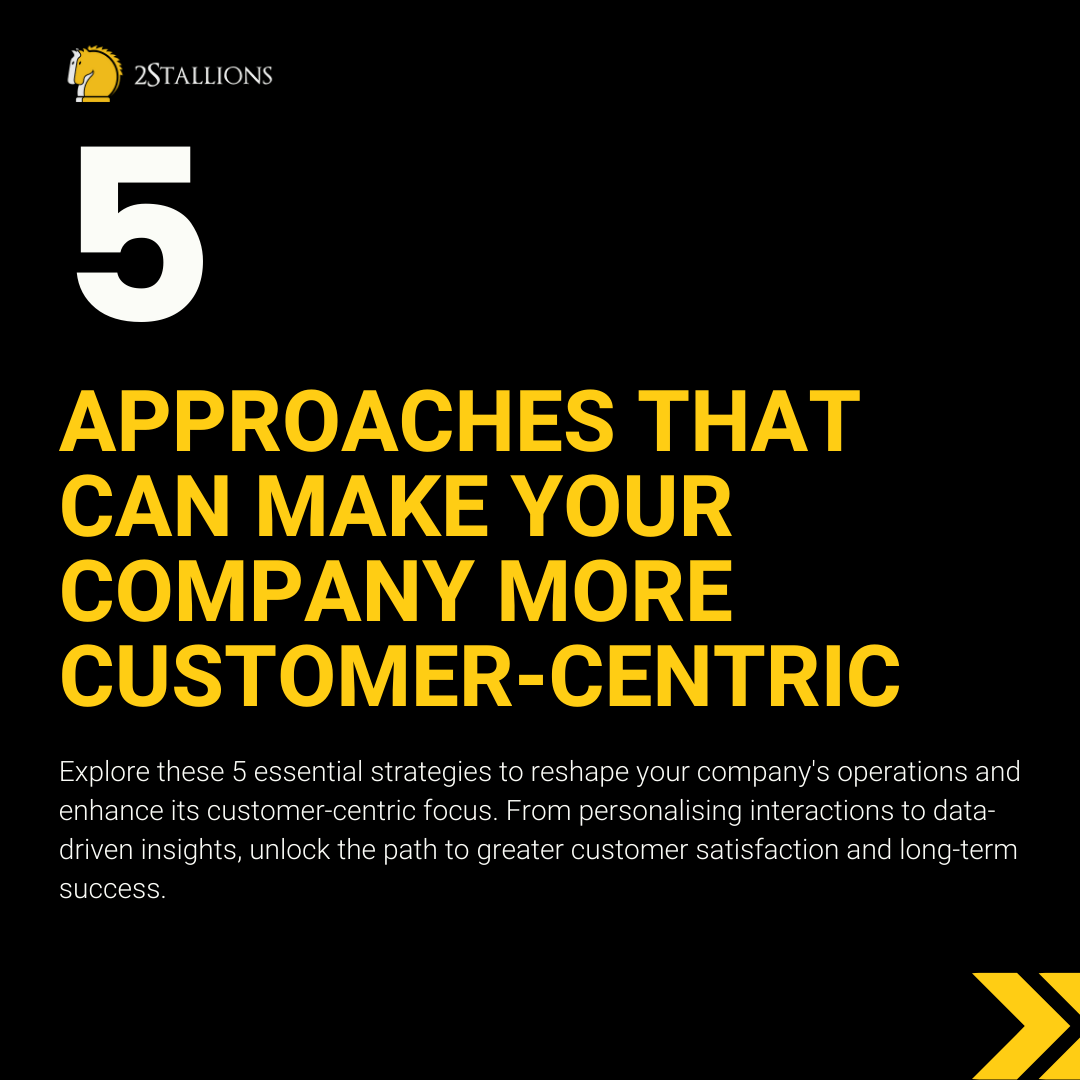Content
SHARE

Today’s marketers face many dilemmas – customers are going mobile, more demanding, and less loyal. Industry leaders have started embracing customer-centricity as a vital way to grow their companies and strategies that are more customer-driven in place of the more traditional business or product-driven ones. However, it is more complex than putting the customer on your priority list. There are other approaches you can employ when it comes to customer-centricity, and most of them revolve around what the customers need.
[thrive_leads id=’8354′]
But before we proceed to those factors, let us first answer an imperative question about this topic.
What Does Being Customer-Centric Mean?
Being customer-centric means placing the customer at the heart of your business philosophy. It involves adopting a set of principles and practices that prioritise your customers’ needs, preferences, and satisfaction. Here’s what it entails:
Customer Focus
A customer-centric business places the customer’s needs and desires at the forefront of its decision-making processes. For instance, Apple’s focus on user-friendly design and intuitive interfaces in their products caters to the needs and preferences of their customers.
Personalisation
It involves tailoring products and services to match the specific requirements of individual customers. Based on a customer’s browsing and purchase history, Amazon’s product recommendations are a prime example of personalisation in action.
Proactive Communication
Embracing a customer-centric approach involves actively engaging with customers, seeking feedback, and addressing their concerns promptly. For instance, Zappos is renowned for its proactive customer service, going the extra mile to address customer inquiries and issues.
Data Utilisation
Customer-centric companies utilise data and analytics to gain a deep understanding of their customer base. Netflix’s recommendation algorithms, which suggest movies and TV shows based on viewing history, showcase how data is harnessed to enhance the customer experience.
Continuous Improvement
Embracing a customer-centric approach means a commitment to ongoing improvement. Starbucks regularly updates its menu and store layouts based on customer feedback and changing trends, demonstrating a dedication to continuous enhancement.
Employee Involvement
Creating a customer-centric culture necessitates involving employees at all levels. Every team member should understand and embrace the importance of customer satisfaction. The Ritz-Carlton empowers its staff to make on-the-spot decisions to resolve customer issues, promoting a culture of exceptional customer service.
Long-Term Focus
Customer-centric businesses prioritise long-term customer relationships over short-term gains. Companies like Patagonia, with their commitment to sustainability and ethical practices, build brand loyalty and long-lasting customer relationships based on shared values.
Benefits of Customer-Centricity
- Increased Customer Loyalty: When businesses show a genuine interest in meeting their customers’ needs, it fosters loyalty and trust, leading to repeat business.
- Enhanced Customer Satisfaction: Customer-centric businesses ensure higher customer satisfaction by providing personalised experiences and solving specific problems.
- Improved Brand Reputation: Customer-centric companies often enjoy a positive reputation and word-of-mouth referrals, which can attract more customers.
- Higher Sales and Revenue: Tailoring products and services to customer preferences can increase sales and revenue as it addresses precisely what the customer wants.
- Innovative Product Development: Understanding the customer’s pain points and preferences can drive innovation and the development of products that better meet their needs.
- Cost Efficiency: Focusing on customer-centricity can lead to better resource allocation, reducing wastage and improving overall cost efficiency.
5 Approaches That Can Make Your Company More Customer-Centric
Companies that prioritise customer-centric approaches tend to outperform their competitors in various ways. Here, we will explore five strategies to shift your business towards a customer-centric model and discuss the benefits of this approach.
1. Embrace Consumer-Centric Marketing
In today’s dynamic business landscape, fostering customer-centricity is a fundamental strategy to thrive. Shifting from a product-centric to a consumer-centric marketing approach can bring substantial benefits, such as enhanced customer relationships, improved brand loyalty, increased sales, and higher customer retention rates.
Customer-Centric vs. Product-Centric
In a product-centric approach, companies primarily focus on creating and promoting their products, often neglecting their customers’ evolving needs and preferences. This traditional approach can lead to missed opportunities, as it might not cater to the constantly changing demands of the market. On the other hand, a customer-centric approach necessitates a significant shift in perspective, placing the customer at the centre of all decision-making processes.
The Impact of Customer-Centricity
The transformation towards a consumer-centric marketing strategy has a profound impact on the way a company operates. Here’s how it affects various aspects of business:
Listening and Learning
In a customer-centric model, actively listening to customer feedback becomes a priority. Companies collect and analyse data from various touchpoints, such as social media, surveys, and customer support interactions. For example, a clothing retailer can gather feedback on their latest collection through social media polls and use this information to refine future designs.
Understanding Pain Points
Recognising and addressing customer pain points is essential. A technology company, for instance, may identify that customers struggle with the setup process for their devices. The company can alleviate these pain points by providing detailed, user-friendly setup guides and responsive customer support.
Tailored Marketing Efforts
A customer-centric approach involves creating marketing campaigns and product offerings tailored to customer expectations. An example could be a subscription-based streaming service that offers different content packages to cater to the diverse viewing preferences of its subscribers.
2. Prioritise Customer Experience
A seamless and enjoyable customer experience is undeniably fundamental for a customer-centric company. The focus is on tailoring every aspect of the business to cater to the unique needs and desires of the customer. To appreciate the benefits of customer centricity, it is crucial to evaluate each touchpoint your customers have with your business, holistically embracing the customer’s perspective. Let’s delve deeper into this concept:
Initial Website Interaction
With a customer-centric strategy, your website serves as the entrance to a customised experience. Implement user-friendly design and navigation and offer tailored recommendations based on past behaviour. For instance, Amazon’s homepage greets customers with “Recommended for You” items, demonstrating a deep understanding of individual preferences.
Purchase Process
Simplify the purchasing process. Allow customers to choose from multiple payment options and provide real-time shipping updates. Apple’s online store excels with its smooth and secure payment process and order tracking.
Post-Purchase Support
After the sale, ensure that customers have easy access to assistance. A customer-centric business provides 24/7 support, clear return policies, and detailed FAQs. Zappos, an online shoe and clothing retailer, is renowned for its exceptional post-purchase customer service, which includes free returns and a dedicated customer service team.
By meticulously scrutinising these touchpoints, you can identify areas for improvement. For instance, consider feedback from online surveys, social media, or customer reviews to understand where the customer experience can be enhanced. It could be streamlining the checkout process, offering more detailed product information, or simply responding faster to customer inquiries.
The ultimate result is a boost to your bottom line. Loyal customers spend more, reducing customer acquisition costs. Moreover, the positive word-of-mouth generated by happy customers can attract new business. According to a Nielsen report, 92% of consumers trust recommendations from friends and family over all other forms of advertising. This demonstrates the profound effect a customer-centric approach can have on your company’s growth.
3. Customer-Centric vs. Product-Centric Approach
A customer-centric approach places the customer at the core of the business strategy. It involves tailoring products and services to match customer demands, which leads to increased customer satisfaction and long-term loyalty. While a product-centric approach can yield short-term gains, customer-centric companies enjoy sustainable success and higher customer lifetime value.
In a product-centric paradigm, businesses often develop products based on their internal expertise and assumptions rather than listening to what their customers truly want. For example, a smartphone manufacturer may release a new model with upgraded features, assuming these improvements align with consumer preferences. However, if these enhancements address their target audience’s specific needs or desires, the product may perform better in the market.
In contrast, companies that adopt a customer-centric approach conduct extensive market research, gather customer feedback, and actively listen to their target audience. They aim to understand their customers’ pain points, desires, and preferences. This approach often leads to developing products and services tailored to these specific customer requirements. For instance, an eCommerce platform may offer personalised product recommendations based on a customer’s browsing and purchase history, enhancing the overall shopping experience.
The advantages of embracing customer-centricity are extensive. This approach cultivates profound connections with your customer base, resulting in heightened brand loyalty and greater customer satisfaction. For instance, a customer-centric airline may offer personalised services like tailored in-flight entertainment options or specialised meals for passengers with dietary restrictions, elevating the overall travel experience.
4. Personalise Customer Interactions
Personalisation is a central component of customer-centric businesses. In a world where consumers have abundant choices, understanding the importance of customer-centricity can be a game-changer for companies. This approach to doing business revolves around putting the customer at the core of all operations.
It recognises that satisfying individual needs and preferences leads to higher customer satisfaction, loyalty, and profitability. The impact of customer-centricity on a business is profound. When companies embrace customer-centric practices, they often experience increased customer satisfaction and retention. One of the critical elements in achieving this is personalisation. Here are some examples of how this can be implemented:
eCommerce Recommendations
Online retailers like Amazon employ personalised product recommendations based on a customer’s browsing and purchase history. For instance, if a customer frequently buys books on gardening, the platform will suggest gardening tools and related books.
Customised Email Marketing
Companies often use email marketing campaigns that address customers by their first name and recommend products or services based on their previous interactions. This personal touch makes the email more engaging and relevant.
AI-Powered Chatbots
Chatbots can use artificial intelligence to personalise responses based on the customer’s questions and history. For instance, a customer asking about product returns will receive different answers than someone inquiring about new product releases.
In-Store Personalisation
In brick-and-mortar stores, staff can use customer data to provide tailored assistance. For example, a customer in a technology store might be guided to the latest tech gadgets if their previous purchases and preferences align with such products.
Tailored Content
Content providers, like streaming services, use personalisation to recommend movies, TV shows, or music based on viewing or listening history. This ensures that customers are more likely to engage with the content.
5. Gather and Act on Customer Feedback
Regularly collecting and acting upon customer feedback is a fundamental aspect of customer-centricity. The shift towards consumer-centric marketing has gained immense importance. Customer-centricity prioritises understanding and satisfying the needs and preferences of individual customers. One of the key strategies to achieve this is to engage with customer feedback actively. Here’s how you can harness the power of customer feedback to exemplify customer-centricity, highlighting the benefits that come with it:
Encourage Customers to Share their Opinions and Concerns
Start by creating multiple touchpoints for your customers to provide feedback. This can include online surveys, feedback forms, and even direct engagement through social media. For instance, an eCommerce company may send post-purchase emails, asking customers to rate their shopping experience and provide comments. This promotes transparency and openness, fostering trust between the customer and the brand.
Actively Listen to Their Input
Collecting feedback is only the first step. To truly embrace customer-centricity, you must actively listen to what your customers are saying. For example, a restaurant owner might regularly monitor online review platforms to tally the number of stars and understand the nuances of the reviews. This deep level of engagement helps you decipher what truly matters to your customers.
Use their Feedback to Make Necessary Improvements
Analyse your feedback and use it to improve your products, services, and business processes. Consider a software company that continually updates its applications based on user suggestions and bug reports. This enhances the user experience and shows customers that their input is valued.
Convert Feedback into Advocacy
Customers who see their suggestions and concerns addressed are likelier to become loyal advocates for your brand. This transforms customer satisfaction into a powerful marketing tool. A prime example is Apple, which has built a dedicated fan base through iterative product improvements driven by feedback, leading to word-of-mouth promotion and increased brand loyalty.
Looking for ways to elevate your online presence? Look no further than 2Stallions – a digital marketing firm that’s dedicated to helping businesses succeed. With our team of experts, we can help you light up your website, attract a larger audience, and connect with your perfect market. Partner with us and let’s achieve epic success together!
Originally published: 21 September 2017
Updated: 8 November 2023
Frequently Asked Questions about Customer-Centric Approach
What Are Customer-Centric Approaches?
Customer-centric approaches are strategies and practices employed by businesses to prioritise the needs, preferences, and overall satisfaction of their customers. They involve putting the customer at the core of all business decisions and operations.
What Is An Example Of A Customer-Centric Approach?
One example of a customer-centric approach is personalised marketing. This approach tailors product recommendations and marketing messages to individual customers based on their past behaviours and preferences, enhancing their overall shopping experience.
What Are The Three Main Approaches To Customer Centricity?
The three main approaches to customer centricity are:
a. Customer-Focused Culture: Building a corporate culture where every employee understands and values customer satisfaction.
b. Data-Driven Insights: Using data and analytics to gain a deep understanding of customer behaviour and preferences.
c. Tailored Customer Experiences: Customising products, services, and interactions to meet customer needs and expectations.
What Is A Customer-Centric Approach To Decision-Making?
A customer-centric approach to decision-making involves considering the potential impact of a decision on the customer’s experience and satisfaction. It means making choices that prioritise customer needs and preferences over purely internal or profit-driven factors.
Why Is A Customer-Centric Approach Critical?
A customer-centric approach is crucial because it increases customer loyalty, higher customer retention rates, and improves brand reputation. It can also drive business growth by ensuring that products and services align with what customers truly want and need, ultimately resulting in higher revenue and long-term success.














